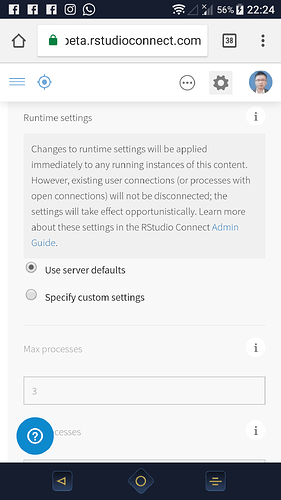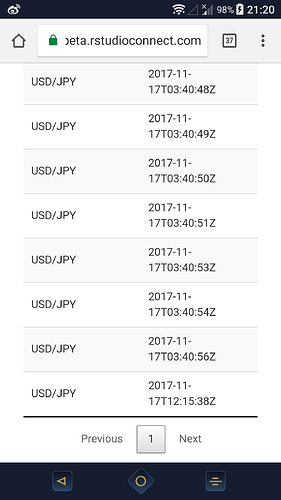I tried to write a web application DataCollection to stored real time forex data. However I noticed that the shiny app will not keep going on after close the browser (As I noted from Persistent R sessions in Shiny Server?)... Is there any solution or better way to made the web application keep going on even though closed browser?
require('shiny')
require('shinyTime')
#'@ require('rdrop2')
require('magrittr')
require('plyr')
require('dplyr')
require('stringr')
require('data.table')
#'@ require('rvest')
require('quantmod')
require('TFX')
require('lubridate')
require('ggplot2')
require('DT')
#'@ drop_auth()
## email : scibrokes_demo@gmail.com
## pass : trader888
#
# https://github.com/karthik/rdrop2
#
#'@ token <- drop_auth()
#'@ saveRDS(token, "droptoken.rds")
# Upload droptoken to your server
# ******** WARNING ********
# Losing this file will give anyone
# complete control of your Dropbox account
# You can then revoke the rdrop2 app from your
# dropbox account and start over.
# ******** WARNING ********
# read it back with readRDS
#'@ token <- readRDS("droptoken.rds")
# Then pass the token to each drop_ function
#'@ drop_acc(dtoken = token)
#'@ token <<- readRDS("droptoken.rds")
# Then pass the token to each drop_ function
#'@ drop_acc(dtoken = token)
# === Data =====================================================
Sys.setenv(TZ = 'Asia/Tokyo')
zones <- attr(as.POSIXlt(now('Asia/Tokyo')), 'tzone')
zone <- ifelse(zones[[1]] == '', paste(zones[-1], collapse = '/'), zones[[1]])
# === UI =====================================================
ui <- shinyUI(fluidPage(
titlePanel(
tags$a(href='https://github.com/scibrokes', target='_blank',
tags$img(height = '120px', alt='HFT', #align='right',
src='https://raw.githubusercontent.com/scibrokes/real-time-fxcm/master/www/HFT.jpg'))),
pageWithSidebar(
mainPanel(
tabsetPanel(
tabPanel('Data Price',
tabsetPanel(
tabPanel('Board',
h3('Real Time Board'),
p(strong(paste0('Current time (', zone, '):')),
textOutput('currentTime')),
br(),
p(strong('Latest FX Quotes:'),
tableOutput('fxdata'),
checkboxInput('pause', 'Pause updates', FALSE))),
tabPanel('Chart',
h3('Real Time Chart'),
p(strong(paste0('Current time (', zone, '):')),
textOutput('currentTime2')),
br(),
plotOutput("plotPrice")#,
#'@ tags$hr(),
#'@ plotOutput("plotAskPrice")
),
tabPanel('Data',
h3('Data Download'),
p(strong(paste0('Current time (', zone, '):')),
textOutput('currentTime3')),
p('The time zone of data in GMT, Current time (GMT) :',
textOutput('currentTime4')),
dataTableOutput('fxDataTable'),
p(strong('Refresh'), 'button will collect the latest dataset ',
'(time unit in seconds).'),
p('Please becareful, once you click on',
strong('Reset'), 'button, ',
'all data will be lost. Kindly download the dataset ',
'as csv format prior to reset it.'),
actionButton('refresh', 'Refresh', class = 'btn-primary'),
downloadButton('downloadData', 'Download'),
actionButton('reset', 'Reset', class = 'btn-danger')))),
tabPanel('Appendix',
tabsetPanel(
tabPanel('Reference',
h3('Speech'),
p('I try to refer to the idea from below reference to create this web ',
'application for data collection.'),
p(HTML("<a href='https://beta.rstudioconnect.com/content/3138/'>Q1App2</a>"),
'(', strong('Q1App2'), 'inside 2nd reference link at below',
strong('Reference'), 'tab) for algorithmic trading. Kindly browse over',
HTML("<a href='https://github.com/scibrokes/real-time-fxcm'>Real Time FXCM</a>"),
'for more information about high frequency algorithmic trading.'),
br(),
h3('Reference'),
p('01. ', HTML("<a href='https://github.com/cran/TFX'>TFX r package</a>")),
p('02. ', HTML("<a href='https://www.fxcmapps.com/apps/basic-historical-data-downloader/'>Basic Historical Data Downloader</a>")),
p('03. ', HTML("<a href='https://github.com/englianhu/binary.com-interview-question'>binary.com : Job Application - Quantitative Analyst</a>"))),
tabPanel('Author',
h3('Author'),
tags$iframe(src = 'https://beta.rstudioconnect.com/content/3091/ryo-eng.html',
height = 800, width = '100%', frameborder = 0)))))),
br(),
p('Powered by - Copyright® Intellectual Property Rights of ',
tags$a(href='http://www.scibrokes.com', target='_blank',
tags$img(height = '20px', alt='scibrokes', #align='right',
src='https://raw.githubusercontent.com/scibrokes/betting-strategy-and-model-validation/master/regressionApps/oda-army.jpg')),
HTML("<a href='http://www.scibrokes.com'>Scibrokes®</a>")))))
# === Server =====================================================
server <- shinyServer(function(input, output, session){
output$currentTime <- renderText({
# Forces invalidation in 1000 milliseconds
invalidateLater(1000, session)
as.character(now('Asia/Tokyo'))
})
output$currentTime2 <- renderText({
# Forces invalidation in 1000 milliseconds
invalidateLater(1000, session)
as.character(now('Asia/Tokyo'))
})
output$currentTime3 <- renderText({
# Forces invalidation in 1000 milliseconds
invalidateLater(1000, session)
as.character(now('Asia/Tokyo'))
})
output$currentTime4 <- renderText({
# Forces invalidation in 1000 milliseconds
invalidateLater(1000, session)
as.character(now('GMT'))
})
fetchData <- reactive({
if (!input$pause)
invalidateLater(750)
qtf <- QueryTrueFX()
qtf %<>% mutate(TimeStamp = as.character(TimeStamp))
names(qtf)[6] <- 'TimeStamp (GMT)'
return(qtf)
})
output$fxdata <- renderTable({
update_data()
fetchData()
}, digits = 5, row.names = FALSE)
# Function to get new observations
get_new_data <- function(){
readLines('http://webrates.truefx.com/rates/connect.html')
}
## ----------------- Start fxData ---------------------------
# Initialize fxData
fxData <<- get_new_data()
# Function to update fxData, latest data will be showing upside.
update_data <- function(){
fxData <<- rbind(fxData, get_new_data())# %>% unique
saveRDS(fxData, paste0(str_replace_all(now('GMT'), ':', 'T'), 'GMT.rds'))
}
output$plotPrice <- renderPlot({
invalidateLater(1000, session)
#update_data()
if(any(file.exists(paste0(dir(pattern = '.rds'))))) {
realPlot <<- llply(dir(pattern = '.rds'), readRDS)
realPlot <<- do.call(rbind, realPlot) %>% unique
realPlot <<- ldply(realPlot, ParseTrueFX) %>% unique %>%
filter(Symbol == 'USD/JPY')
}
if(nrow(realPlot) > 10) {
ggplot(tail(realPlot, 10), aes(TimeStamp)) +
geom_line(aes(y = Bid.Price, colour = 'Bid.Price')) +
geom_line(aes(y = Ask.Price, colour = 'Ask.Price')) +
ggtitle('Real Time USD/JPY')
} else {
ggplot(realPlot, aes(TimeStamp)) +
geom_line(aes(y = Bid.Price, colour = 'Bid.Price')) +
geom_line(aes(y = Ask.Price, colour = 'Ask.Price')) +
ggtitle('Real Time USD/JPY')
}
})
#'@ output$plotAskPrice <- renderPlot({
#'@ invalidateLater(1000, session)
#'@ update_data()
#'@
#'@ dt <- terms()
#'@ if(nrow(dt) > 40) {
#'@ ggplot(data = tail(dt, 40), aes(x = TimeStamp, y = Ask.Price,
#'@ group = Symbol, colour = Symbol)) +
#'@ geom_line() + geom_point( size = 4, shape = 21, fill = 'white') +
#'@ ggtitle('Real Time Graph 2 : Forex Ask Price')
#'@
#'@ } else {
#'@ ggplot(data = dt, aes(x = TimeStamp, y = Ask.Price,
#'@ group = Symbol, colour = Symbol)) +
#'@ geom_line() + geom_point( size = 4, shape = 21, fill = 'white') +
#'@ ggtitle('Real Time Graph 2 : Forex Ask Price')
#'@ }
#'@ })
## ------------------ End fxData ----------------------------
terms <- reactive({
input$refresh
if(any(file.exists(paste0(dir(pattern = '.rds'))))) {
realData <<- llply(dir(pattern = '.rds'), readRDS)
realData <<- do.call(rbind, realData) %>% unique
realData <<- ldply(realData, ParseTrueFX) %>% unique
}
})
# Downloadable csv
output$downloadData <- downloadHandler(
filename = function() {
paste('fxData.csv', sep = '')
},
content = function(file) {
fwrite(terms(), file, row.names = FALSE)
}
)
observe({
if(input$reset){
do.call(file.remove, list(dir(pattern = '.rds')))
rm(list = ls())
stopApp('Delete all downloaded dataset!')
}
})
output$fxDataTable <- renderDataTable({
terms() %>% datatable(
caption = "Table : Forex",
escape = FALSE, filter = "top", rownames = FALSE,
extensions = list("ColReorder" = NULL, "RowReorder" = NULL,
"Buttons" = NULL, "Responsive" = NULL),
options = list(dom = 'BRrltpi', scrollX = TRUE, #autoWidth = TRUE,
lengthMenu = list(c(10, 50, 100, -1), c('10', '50', '100', 'All')),
ColReorder = TRUE, rowReorder = TRUE,
buttons = list('copy', 'print',
list(extend = 'collection',
buttons = c('csv', 'excel', 'pdf'),
text = 'Download'), I('colvis'))))
})
# Set this to "force" instead of TRUE for testing locally (without Shiny Server)
session$allowReconnect(TRUE)
llply(c('plotPrice', 'fxdata', 'fxDataTable'), function(x) {
outputOptions(output, x, suspendWhenHidden = FALSE)
})
})
shinyApp(ui, server)



